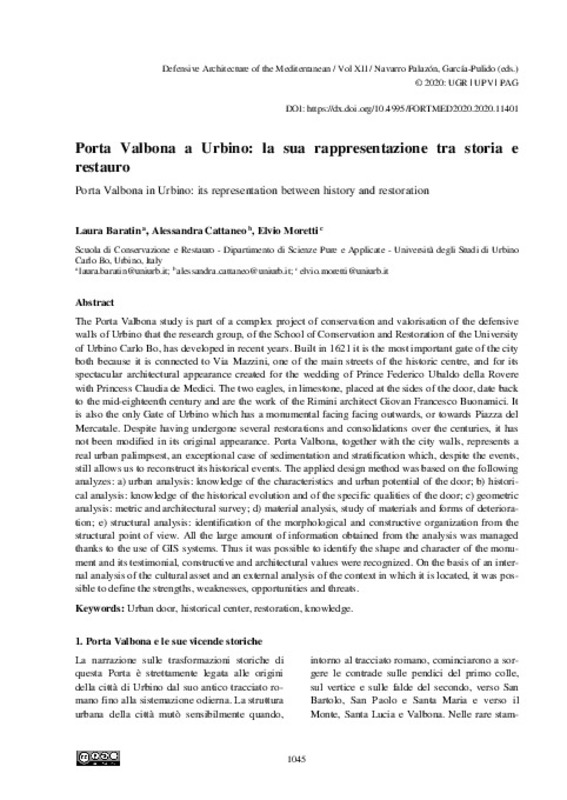JavaScript is disabled for your browser. Some features of this site may not work without it.
Buscar en RiuNet
Listar
Mi cuenta
Estadísticas
Ayuda RiuNet
Admin. UPV
Porta Valbona a Urbino: la sua rappresentazione tra storia e restauro
Mostrar el registro sencillo del ítem
Ficheros en el ítem
| dc.contributor.author | Baratin, Laura
|
es_ES |
| dc.contributor.author | Cattaneo, Alessandra
|
es_ES |
| dc.contributor.author | Moretti, Elvio
|
es_ES |
| dc.coverage.spatial | east=12.634652853012085; north=43.724676685609495; name=Borgo Mercatale, 109, 61029 Urbino PU, Itàlia | es_ES |
| dc.date.accessioned | 2020-07-14T10:18:07Z | |
| dc.date.available | 2020-07-14T10:18:07Z | |
| dc.date.issued | 2020-05-15 | |
| dc.identifier.isbn | 9788490488560 | |
| dc.identifier.uri | http://hdl.handle.net/10251/147964 | |
| dc.description.abstract | [EN] The Porta Valbona study is part of a complex project of conservation and valorisation of the defensive walls of Urbino that the research group, of the School of Conservation and Restoration of the University of Urbino Carlo Bo, has developed in recent years. Built in 1621 it is the most important gate of the city both because it is connected to Via Mazzini, one of the main streets of the historic centre, and for its spectacular architectural appearance created for the wedding of Prince Federico Ubaldo della Rovere with Princess Claudia de Medici. The two eagles, in limestone, placed at the sides of the door, date back to the mid-eighteenth century and are the work of the Rimini architect Giovan Francesco Buonamici. It is also the only Gate of Urbino which has a monumental facing facing outwards, or towards Piazza del Mercatale. Despite having undergone several restorations and consolidations over the centuries, it has not been modified in its original appearance. Porta Valbona, together with the city walls, represents a real urban palimpsest, an exceptional case of sedimentation and stratification which, despite the events, still allows us to reconstruct its historical events. The applied design method was based on the following analyzes: a) urban analysis: knowledge of the characteristics and urban potential of the door; b) historical analysis: knowledge of the historical evolution and of the specific qualities of the door; c) geometric analysis: metric and architectural survey; d) material analysis, study of materials and forms of deterioration; e) structural analysis: identification of the morphological and constructive organization from the structural point of view. All the large amount of information obtained from the analysis was managed thanks to the use of GIS systems. Thus it was possible to identify the shape and character of the monument and its testimonial, constructive and architectural values were recognized. On the basis of an internal analysis of the cultural asset and an external analysis of the context in which it is located, it was possible to define the strengths, weaknesses, opportunities and threats. | es_ES |
| dc.language | Italiano | es_ES |
| dc.publisher | Editorial Universitat Politècnica de València | es_ES |
| dc.rights | Reconocimiento - No comercial - Sin obra derivada (by-nc-nd) | es_ES |
| dc.subject | Fortifications | es_ES |
| dc.subject | Mediterranean | es_ES |
| dc.subject | Modern age | es_ES |
| dc.subject | Built Heritage | es_ES |
| dc.subject | Urban door | es_ES |
| dc.subject | Historical center | es_ES |
| dc.subject | Restoration | es_ES |
| dc.subject | Knowledge | es_ES |
| dc.title | Porta Valbona a Urbino: la sua rappresentazione tra storia e restauro | es_ES |
| dc.title.alternative | Porta Valbona in Urbino: its representation between history and restoration | es_ES |
| dc.type | Capítulo de libro | es_ES |
| dc.type | Comunicación en congreso | es_ES |
| dc.identifier.doi | 10.4995/FORTMED2020.2020.11401 | |
| dc.rights.accessRights | Abierto | es_ES |
| dc.description.bibliographicCitation | Baratin, L.; Cattaneo, A.; Moretti, E. (2020). Porta Valbona a Urbino: la sua rappresentazione tra storia e restauro. Editorial Universitat Politècnica de València. 1045-1052. https://doi.org/10.4995/FORTMED2020.2020.11401 | es_ES |
| dc.description.accrualMethod | OCS | es_ES |
| dc.relation.conferencename | FORTMED2020 - Defensive Architecture of the Mediterranean | es_ES |
| dc.relation.conferencedate | Octubre 01-03,2020 | es_ES |
| dc.relation.conferenceplace | Granada, Spain | es_ES |
| dc.relation.publisherversion | http://ocs.editorial.upv.es/index.php/FORTMED/FORTMED2020/paper/view/11401 | es_ES |
| dc.description.upvformatpinicio | 1045 | es_ES |
| dc.description.upvformatpfin | 1052 | es_ES |
| dc.type.version | info:eu-repo/semantics/publishedVersion | es_ES |
| dc.relation.pasarela | OCS\11401 | es_ES |








